Hybrid - Key agreement protocol based on chebyshev polynomials
This paper presented implementation of the Chebyshev permutation polynomials on hardware. The experimental results demonstrate that this is an efficient way to calculate the Chebyshev polynomials in a prime field. According to the hardware structure of the Chebyshev polynomial, a Hybrid-Key Agreement Protocol is proposed. The purpose of our protocol is to enable two end-users exchanging a secret session key using both the key distribution center and the Chebyshev-based public key encryption. Advantage of publickey encryption is authentic and confidential for delivering secret keys, the addition of KDCs serves a widely distributed set of users. The proposed key agreement protocol offers satisfactory security and can be implemented hardware efficiently suitable for the low resource utilization
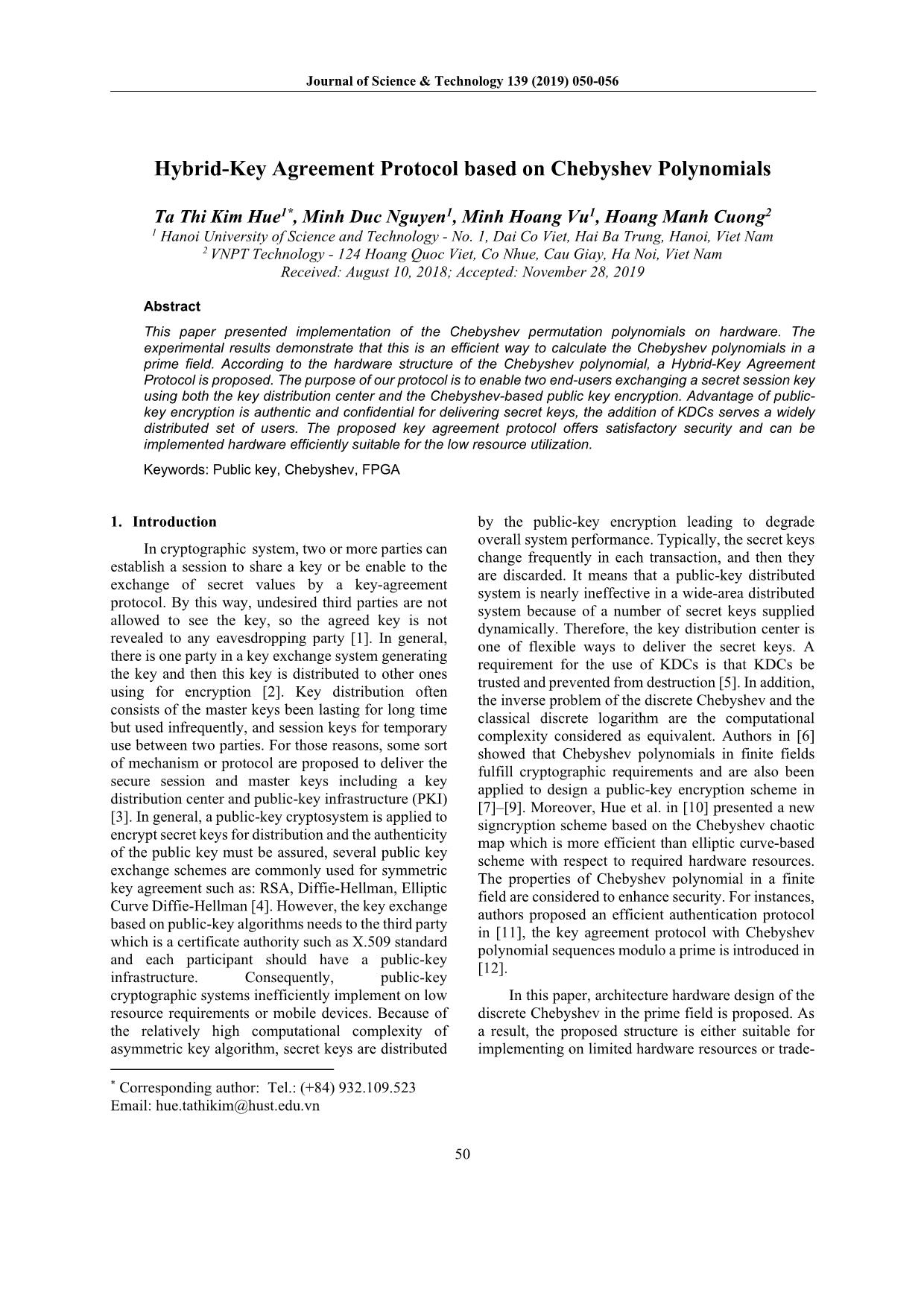
Trang 1
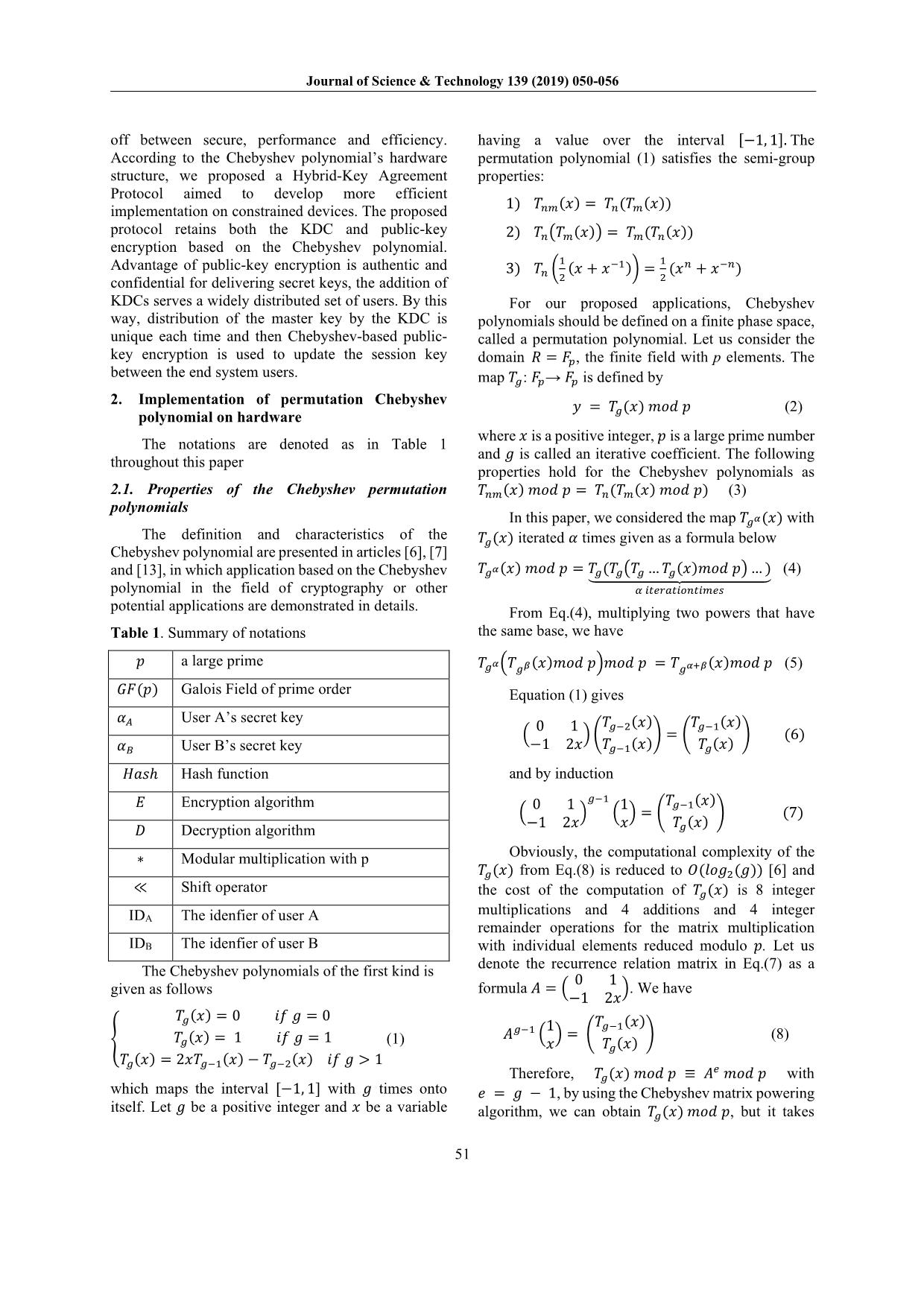
Trang 2
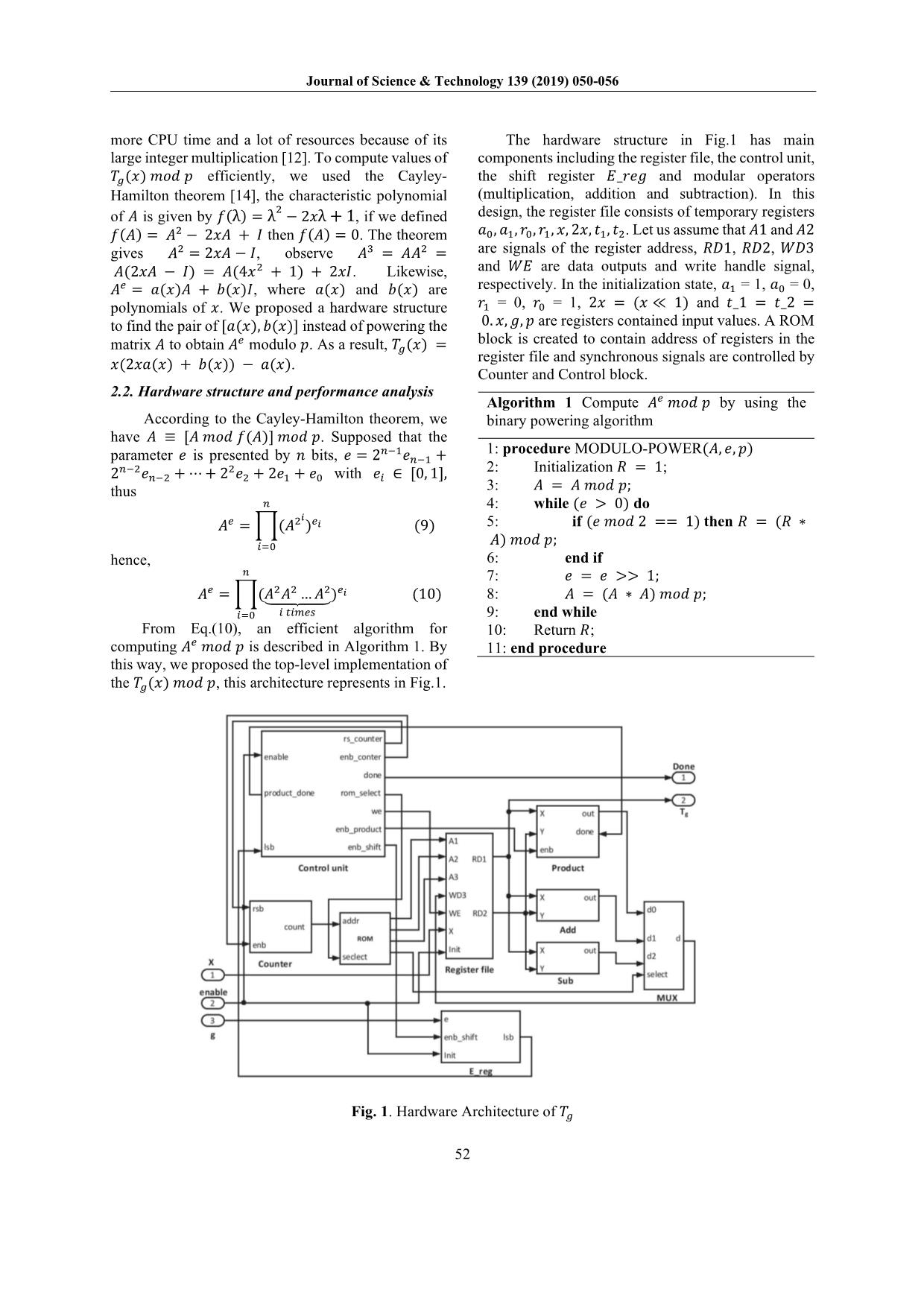
Trang 3
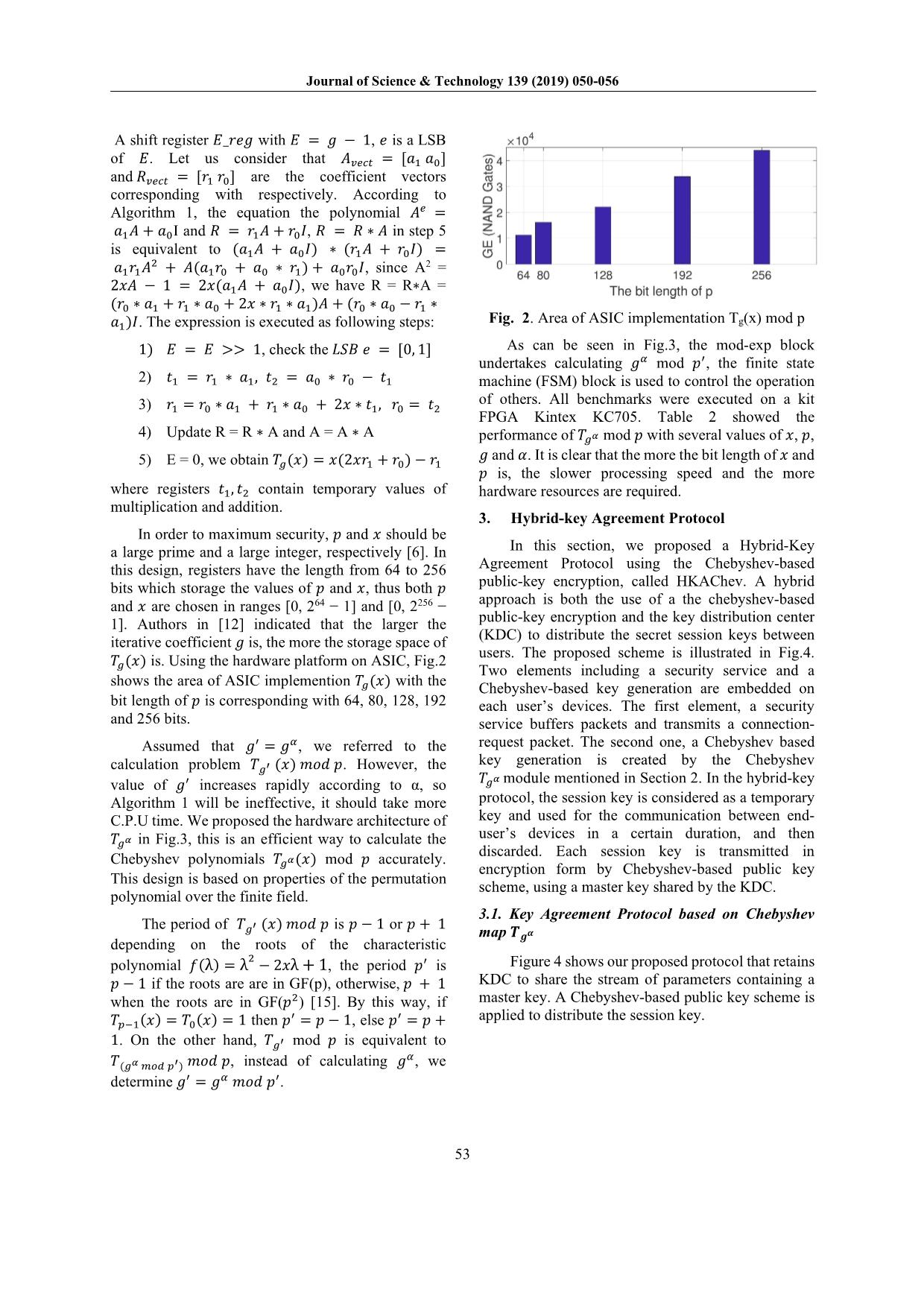
Trang 4
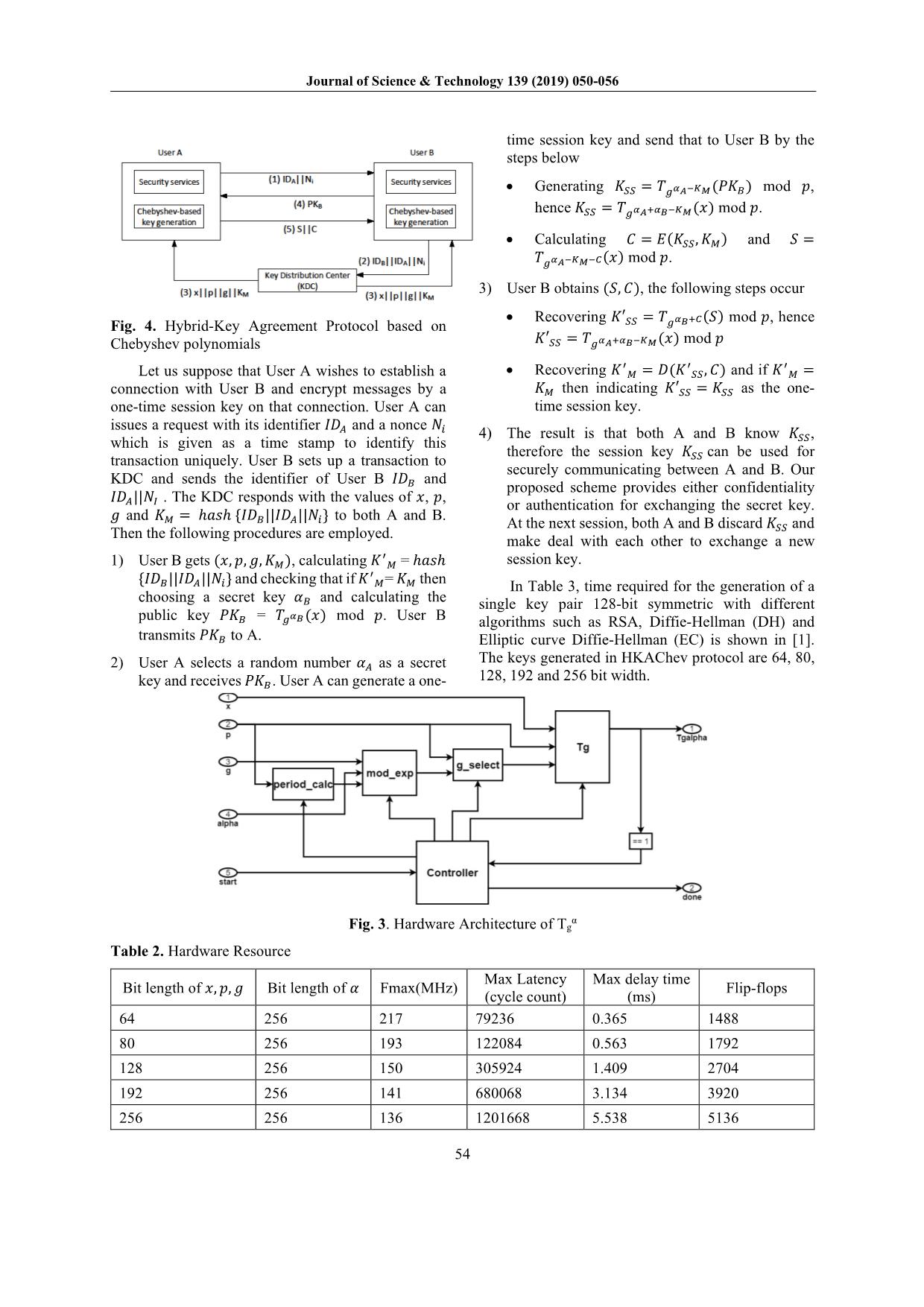
Trang 5
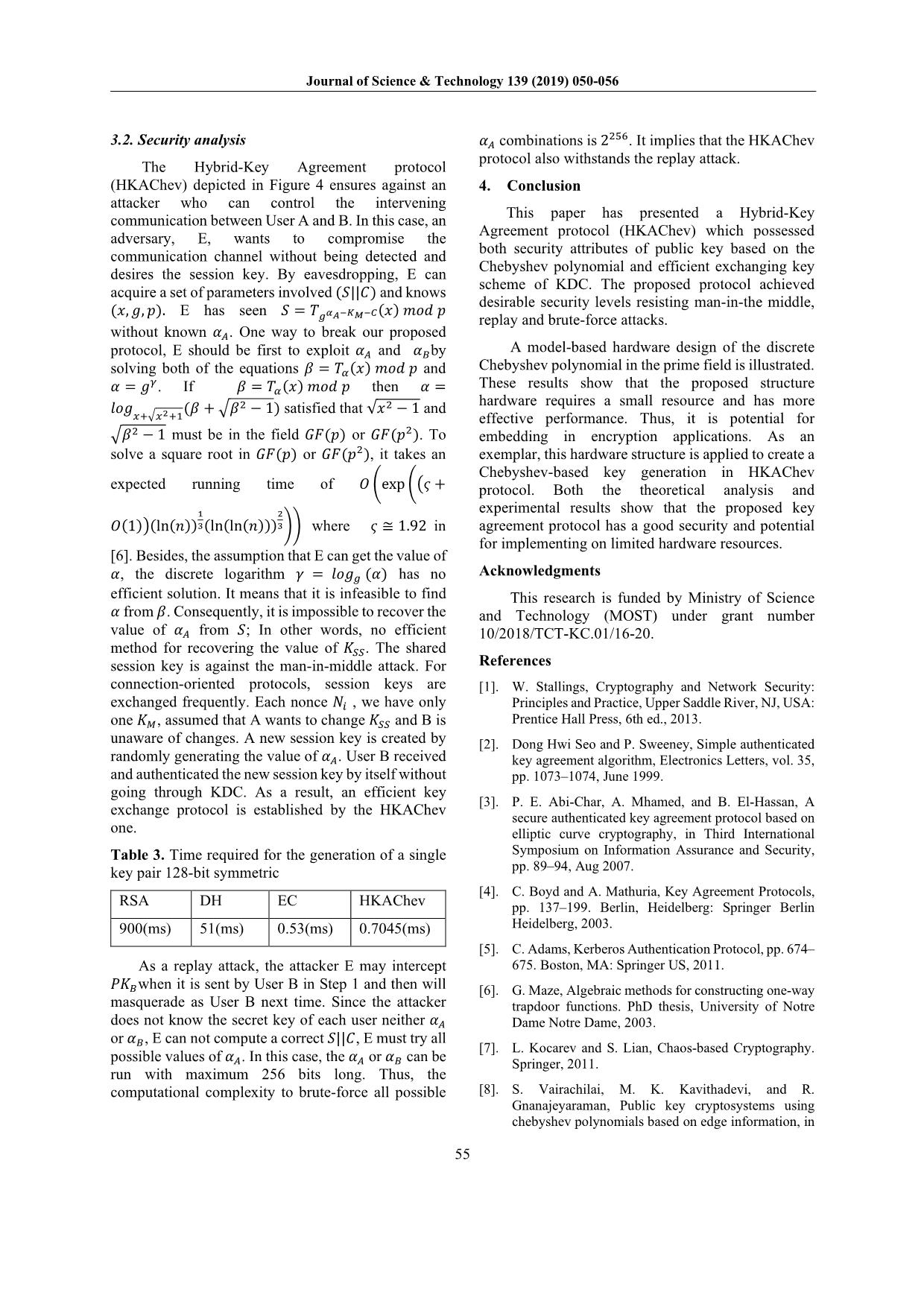
Trang 6
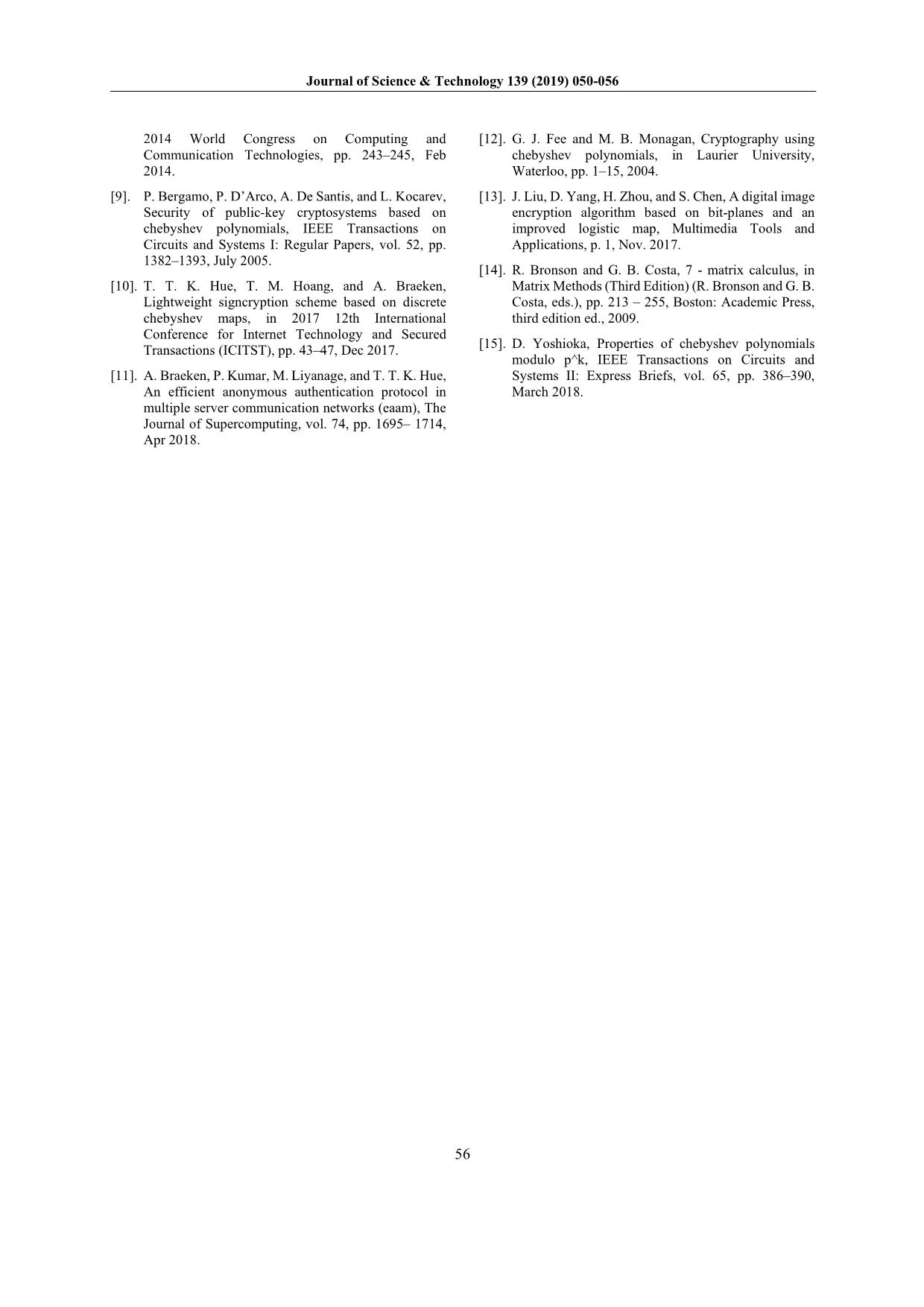
Trang 7
Tóm tắt nội dung tài liệu: Hybrid - Key agreement protocol based on chebyshev polynomials
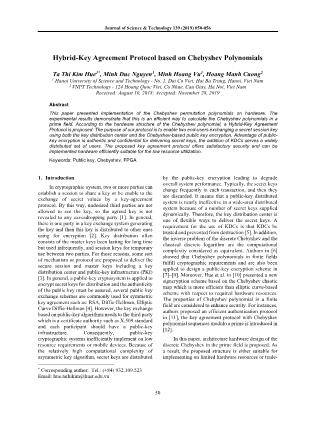
Journal of Science & Technology 139 (2019) 050-056
50
Hybrid-Key Agreement Protocol based on Chebyshev Polynomials
Ta Thi Kim Hue1*, Minh Duc Nguyen1, Minh Hoang Vu1, Hoang Manh Cuong2
1 Hanoi University of Science and Technology - No. 1, Dai Co Viet, Hai Ba Trung, Hanoi, Viet Nam
2 VNPT Technology - 124 Hoang Quoc Viet, Co Nhue, Cau Giay, Ha Noi, Viet Nam
Received: August 10, 2018; Accepted: November 28, 2019
Abstract
This paper presented implementation of the Chebyshev permutation polynomials on hardware. The
experimental results demonstrate that this is an efficient way to calculate the Chebyshev polynomials in a
prime field. According to the hardware structure of the Chebyshev polynomial, a Hybrid-Key Agreement
Protocol is proposed. The purpose of our protocol is to enable two end-users exchanging a secret session key
using both the key distribution center and the Chebyshev-based public key encryption. Advantage of public-
key encryption is authentic and confidential for delivering secret keys, the addition of KDCs serves a widely
distributed set of users. The proposed key agreement protocol offers satisfactory security and can be
implemented hardware efficiently suitable for the low resource utilization.
Keywords: Public key, Chebyshev, FPGA
1. Introduction
In cryptographic1system, two or more parties can
establish a session to share a key or be enable to the
exchange of secret values by a key-agreement
protocol. By this way, undesired third parties are not
allowed to see the key, so the agreed key is not
revealed to any eavesdropping party [1]. In general,
there is one party in a key exchange system generating
the key and then this key is distributed to other ones
using for encryption [2]. Key distribution often
consists of the master keys been lasting for long time
but used infrequently, and session keys for temporary
use between two parties. For those reasons, some sort
of mechanism or protocol are proposed to deliver the
secure session and master keys including a key
distribution center and public-key infrastructure (PKI)
[3]. In general, a public-key cryptosystem is applied to
encrypt secret keys for distribution and the authenticity
of the public key must be assured, several public key
exchange schemes are commonly used for symmetric
key agreement such as: RSA, Diffie-Hellman, Elliptic
Curve Diffie-Hellman [4]. However, the key exchange
based on public-key algorithms needs to the third party
which is a certificate authority such as X.509 standard
and each participant should have a public-key
infrastructure. Consequently, public-key
cryptographic systems inefficiently implement on low
resource requirements or mobile devices. Because of
the relatively high computational complexity of
asymmetric key algorithm, secret keys are distributed
* Corresponding author: Tel.: (+84) 932.109.523
Email: hue.tathikim@hust.edu.vn
by the public-key encryption leading to degrade
overall system performance. Typically, the secret keys
change frequently in each transaction, and then they
are discarded. It means that a public-key distributed
system is nearly ineffective in a wide-area distributed
system because of a number of secret keys supplied
dynamically. Therefore, the key distribution center is
one of flexible ways to deliver the secret keys. A
requirement for the use of KDCs is that KDCs be
trusted and prevented from destruction [5]. In addition,
the inverse problem of the discrete Chebyshev and the
classical discrete logarithm are the computational
complexity considered as equivalent. Authors in [6]
showed that Chebyshev polynomials in finite fields
fulfill cryptographic requirements and are also been
applied to design a public-key encryption scheme in
[7]–[9]. Moreover, Hue et al. in [10] presented a new
signcryption scheme based on the Chebyshev chaotic
map which is more efficient than elliptic curve-based
scheme with respect to required hardware resources.
The properties of Chebyshev polynomial in a finite
field are considered to enhance security. For instances,
authors proposed an efficient authentication protocol
in [11], the key agreement protocol with Chebyshev
polynomial sequences modulo a prime is introduced in
[12].
In this paper, architecture hardware design of the
discrete Chebyshev in the prime field is proposed. As
a result, the proposed structure is either suitable for
implementing on limited hardware resources or trade-
Journal of Science & Technology 139 (2019) 050-056
51
off between secure, performance and efficiency.
According to the Chebyshev polynomial’s hardware
structure, we proposed a Hybrid-Key Agreement
Protocol aimed to develop more efficient
implementation on constrained devices. The proposed
protocol retains both the KDC and public-key
encryption based on the Chebyshev polynomial.
Advantage of public-key encryption is authentic and
confidential for delivering secret keys, the addition of
KDCs serves a widely distributed set of users. By this
way, distribution of the master key by the KDC is
unique each time and then Chebyshev-based public-
key encryption is used to update the session key
between the end system users.
2. Implementation of permutation Chebyshev
polynomial on hardware
The notations are denoted as in Table 1
throughout this paper
2.1. Properties of the Chebyshev permutation
polynomials
The definition and characteristics of the
Chebyshev polynomial are presented in articles [6], [7]
and [13], in which application based on the Chebyshev
polynomial in the field of cryptography or other
potential applications are demonstrated in details.
Table 1. Summary of notations
𝑝𝑝 a large prime
𝐺𝐺𝐺𝐺(𝑝𝑝) Galois Field of prime order
𝛼𝛼𝐴𝐴 User A’s secret key
𝛼𝛼𝐵𝐵 User B’s secret key
𝐻𝐻𝐻𝐻𝐻𝐻ℎ Hash function
𝐸𝐸 Encryption algori ... 𝑅𝑅𝑣𝑣𝑖𝑖𝑣𝑣𝑖𝑖 = [𝑟𝑟1 𝑟𝑟0] are the coefficient vectors
corresponding with respectively. According to
Algorithm 1, the equation the polynomial 𝐴𝐴𝑖𝑖 = 𝐻𝐻1𝐴𝐴 + 𝐻𝐻0I and 𝑅𝑅 = 𝑟𝑟1𝐴𝐴 + 𝑟𝑟0𝐼𝐼, 𝑅𝑅 = 𝑅𝑅 ∗ 𝐴𝐴 in step 5
is equivalent to (𝐻𝐻1𝐴𝐴 + 𝐻𝐻0𝐼𝐼) ∗ (𝑟𝑟1𝐴𝐴 + 𝑟𝑟0𝐼𝐼) = 𝐻𝐻1𝑟𝑟1𝐴𝐴2 + 𝐴𝐴(𝐻𝐻1𝑟𝑟0 + 𝐻𝐻0 ∗ 𝑟𝑟1) + 𝐻𝐻0𝑟𝑟0𝐼𝐼, since A2 = 2𝑥𝑥𝐴𝐴 − 1 = 2𝑥𝑥(𝐻𝐻1𝐴𝐴 + 𝐻𝐻0𝐼𝐼), we have R = R∗A = (𝑟𝑟0 ∗ 𝐻𝐻1 + 𝑟𝑟1 ∗ 𝐻𝐻0 + 2𝑥𝑥 ∗ 𝑟𝑟1 ∗ 𝐻𝐻1)𝐴𝐴 + (𝑟𝑟0 ∗ 𝐻𝐻0 − 𝑟𝑟1 ∗
𝐻𝐻1)𝐼𝐼. The expression is executed as following steps: 1) 𝐸𝐸 = 𝐸𝐸 >> 1, check the 𝐿𝐿𝐿𝐿𝐿𝐿 𝑒𝑒 = [0, 1]
2) 𝑡𝑡1 = 𝑟𝑟1 ∗ 𝐻𝐻1, 𝑡𝑡2 = 𝐻𝐻0 ∗ 𝑟𝑟0 − 𝑡𝑡1
3) 𝑟𝑟1 = 𝑟𝑟0 ∗ 𝐻𝐻1 + 𝑟𝑟1 ∗ 𝐻𝐻0 + 2𝑥𝑥 ∗ 𝑡𝑡1, 𝑟𝑟0 = 𝑡𝑡2
4) Update R = R ∗ A and A = A ∗ A
5) E = 0, we obtain 𝑇𝑇𝑔𝑔(𝑥𝑥) = 𝑥𝑥(2𝑥𝑥𝑟𝑟1 + 𝑟𝑟0) − 𝑟𝑟1
where registers 𝑡𝑡1, 𝑡𝑡2 contain temporary values of
multiplication and addition.
In order to maximum security, 𝑝𝑝 and 𝑥𝑥 should be
a large prime and a large integer, respectively [6]. In
this design, registers have the length from 64 to 256
bits which storage the values of 𝑝𝑝 and 𝑥𝑥, thus both 𝑝𝑝
and 𝑥𝑥 are chosen in ranges [0, 264 − 1] and [0, 2256 −
1]. Authors in [12] indicated that the larger the
iterative coefficient 𝑔𝑔 is, the more the storage space of
𝑇𝑇𝑔𝑔(𝑥𝑥) is. Using the hardware platform on ASIC, Fig.2
shows the area of ASIC implemention 𝑇𝑇𝑔𝑔(𝑥𝑥) with the
bit length of 𝑝𝑝 is corresponding with 64, 80, 128, 192
and 256 bits.
Assumed that 𝑔𝑔′ = 𝑔𝑔𝛼𝛼, we referred to the
calculation problem 𝑇𝑇𝑔𝑔′ (𝑥𝑥) 𝑚𝑚𝑚𝑚𝑚𝑚 𝑝𝑝. However, the
value of 𝑔𝑔′ increases rapidly according to α, so
Algorithm 1 will be ineffective, it should take more
C.P.U time. We proposed the hardware architecture of
𝑇𝑇𝑔𝑔𝛼𝛼 in Fig.3, this is an efficient way to calculate the
Chebyshev polynomials 𝑇𝑇𝑔𝑔𝛼𝛼(𝑥𝑥) mod 𝑝𝑝 accurately.
This design is based on properties of the permutation
polynomial over the finite field.
The period of 𝑇𝑇𝑔𝑔′ (𝑥𝑥) 𝑚𝑚𝑚𝑚𝑚𝑚 𝑝𝑝 is 𝑝𝑝 − 1 or 𝑝𝑝 + 1
depending on the roots of the characteristic
polynomial 𝑖𝑖(λ) = λ2 − 2𝑥𝑥λ+ 1, the period 𝑝𝑝′ is
𝑝𝑝 − 1 if the roots are are in GF(p), otherwise, 𝑝𝑝 + 1
when the roots are in GF(𝑝𝑝2) [15]. By this way, if
𝑇𝑇𝑝𝑝−1(𝑥𝑥) = 𝑇𝑇0(𝑥𝑥) = 1 then 𝑝𝑝′ = 𝑝𝑝 − 1, else 𝑝𝑝′ = 𝑝𝑝 +1. On the other hand, 𝑇𝑇𝑔𝑔′ mod 𝑝𝑝 is equivalent to
𝑇𝑇(𝑔𝑔𝛼𝛼 𝑛𝑛𝑖𝑖𝑚𝑚 𝑝𝑝′) 𝑚𝑚𝑚𝑚𝑚𝑚 𝑝𝑝, instead of calculating 𝑔𝑔𝛼𝛼, we
determine 𝑔𝑔′ = 𝑔𝑔𝛼𝛼 𝑚𝑚𝑚𝑚𝑚𝑚 𝑝𝑝′.
Fig. 2. Area of ASIC implementation Tg(x) mod p
As can be seen in Fig.3, the mod-exp block
undertakes calculating 𝑔𝑔𝛼𝛼 mod 𝑝𝑝′, the finite state
machine (FSM) block is used to control the operation
of others. All benchmarks were executed on a kit
FPGA Kintex KC705. Table 2 showed the
performance of 𝑇𝑇𝑔𝑔𝛼𝛼 mod 𝑝𝑝 with several values of 𝑥𝑥, 𝑝𝑝,
𝑔𝑔 and 𝛼𝛼. It is clear that the more the bit length of 𝑥𝑥 and
𝑝𝑝 is, the slower processing speed and the more
hardware resources are required.
3. Hybrid-key Agreement Protocol
In this section, we proposed a Hybrid-Key
Agreement Protocol using the Chebyshev-based
public-key encryption, called HKAChev. A hybrid
approach is both the use of a the chebyshev-based
public-key encryption and the key distribution center
(KDC) to distribute the secret session keys between
users. The proposed scheme is illustrated in Fig.4.
Two elements including a security service and a
Chebyshev-based key generation are embedded on
each user’s devices. The first element, a security
service buffers packets and transmits a connection-
request packet. The second one, a Chebyshev based
key generation is created by the Chebyshev
𝑇𝑇𝑔𝑔𝛼𝛼 module mentioned in Section 2. In the hybrid-key
protocol, the session key is considered as a temporary
key and used for the communication between end-
user’s devices in a certain duration, and then
discarded. Each session key is transmitted in
encryption form by Chebyshev-based public key
scheme, using a master key shared by the KDC.
3.1. Key Agreement Protocol based on Chebyshev
map 𝑻𝑻𝒈𝒈𝜶𝜶
Figure 4 shows our proposed protocol that retains
KDC to share the stream of parameters containing a
master key. A Chebyshev-based public key scheme is
applied to distribute the session key.
Journal of Science & Technology 139 (2019) 050-056
54
Fig. 4. Hybrid-Key Agreement Protocol based on
Chebyshev polynomials
Let us suppose that User A wishes to establish a
connection with User B and encrypt messages by a
one-time session key on that connection. User A can
issues a request with its identifier 𝐼𝐼𝐷𝐷𝐴𝐴 and a nonce 𝑁𝑁𝑖𝑖
which is given as a time stamp to identify this
transaction uniquely. User B sets up a transaction to
KDC and sends the identifier of User B 𝐼𝐼𝐷𝐷𝐵𝐵 and
𝐼𝐼𝐷𝐷𝐴𝐴||𝑁𝑁𝐼𝐼 . The KDC responds with the values of 𝑥𝑥, 𝑝𝑝,
𝑔𝑔 and 𝐾𝐾𝑀𝑀 = ℎ𝐻𝐻𝐻𝐻ℎ {𝐼𝐼𝐷𝐷𝐵𝐵||𝐼𝐼𝐷𝐷𝐴𝐴||𝑁𝑁𝑖𝑖} to both A and B.
Then the following procedures are employed.
1) User B gets (𝑥𝑥, 𝑝𝑝,𝑔𝑔,𝐾𝐾𝑀𝑀), calculating 𝐾𝐾′𝑀𝑀 = ℎ𝐻𝐻𝐻𝐻ℎ {𝐼𝐼𝐷𝐷𝐵𝐵||𝐼𝐼𝐷𝐷𝐴𝐴||𝑁𝑁𝑖𝑖} and checking that if 𝐾𝐾′𝑀𝑀= 𝐾𝐾𝑀𝑀 then
choosing a secret key 𝛼𝛼𝐵𝐵 and calculating the
public key 𝑃𝑃𝐾𝐾𝐵𝐵 = 𝑇𝑇𝑔𝑔𝛼𝛼𝐵𝐵(𝑥𝑥) mod 𝑝𝑝. User B
transmits 𝑃𝑃𝐾𝐾𝐵𝐵 to A.
2) User A selects a random number 𝛼𝛼𝐴𝐴 as a secret
key and receives 𝑃𝑃𝐾𝐾𝐵𝐵 . User A can generate a one-
time session key and send that to User B by the
steps below
• Generating 𝐾𝐾𝑆𝑆𝑆𝑆 = 𝑇𝑇𝑔𝑔𝛼𝛼𝐴𝐴−𝐾𝐾𝑀𝑀(𝑃𝑃𝐾𝐾𝐵𝐵) mod 𝑝𝑝,
hence 𝐾𝐾𝑆𝑆𝑆𝑆 = 𝑇𝑇𝑔𝑔𝛼𝛼𝐴𝐴+𝛼𝛼𝐵𝐵−𝐾𝐾𝑀𝑀(𝑥𝑥) mod 𝑝𝑝.
• Calculating 𝐶𝐶 = 𝐸𝐸(𝐾𝐾𝑆𝑆𝑆𝑆,𝐾𝐾𝑀𝑀) and 𝐿𝐿 =
𝑇𝑇𝑔𝑔𝛼𝛼𝐴𝐴−𝐾𝐾𝑀𝑀−𝐶𝐶(𝑥𝑥) mod 𝑝𝑝.
3) User B obtains (𝐿𝐿,𝐶𝐶), the following steps occur
• Recovering 𝐾𝐾′𝑆𝑆𝑆𝑆 = 𝑇𝑇𝑔𝑔𝛼𝛼𝐵𝐵+𝐶𝐶(𝐿𝐿) mod 𝑝𝑝, hence
𝐾𝐾′𝑆𝑆𝑆𝑆 = 𝑇𝑇𝑔𝑔𝛼𝛼𝐴𝐴+𝛼𝛼𝐵𝐵−𝐾𝐾𝑀𝑀(𝑥𝑥) mod 𝑝𝑝
• Recovering 𝐾𝐾′𝑀𝑀 = 𝐷𝐷(𝐾𝐾′𝑆𝑆𝑆𝑆,𝐶𝐶) and if 𝐾𝐾′𝑀𝑀 =
𝐾𝐾𝑀𝑀 then indicating 𝐾𝐾′𝑆𝑆𝑆𝑆 = 𝐾𝐾𝑆𝑆𝑆𝑆 as the one-
time session key.
4) The result is that both A and B know 𝐾𝐾𝑆𝑆𝑆𝑆,
therefore the session key 𝐾𝐾𝑆𝑆𝑆𝑆 can be used for
securely communicating between A and B. Our
proposed scheme provides either confidentiality
or authentication for exchanging the secret key.
At the next session, both A and B discard 𝐾𝐾𝑆𝑆𝑆𝑆 and
make deal with each other to exchange a new
session key.
In Table 3, time required for the generation of a
single key pair 128-bit symmetric with different
algorithms such as RSA, Diffie-Hellman (DH) and
Elliptic curve Diffie-Hellman (EC) is shown in [1].
The keys generated in HKAChev protocol are 64, 80,
128, 192 and 256 bit width.
Fig. 3. Hardware Architecture of Tgα
Table 2. Hardware Resource
Bit length of 𝑥𝑥, 𝑝𝑝,𝑔𝑔 Bit length of 𝛼𝛼 Fmax(MHz) Max Latency (cycle count) Max delay time (ms) Flip-flops
64 256 217 79236 0.365 1488
80 256 193 122084 0.563 1792
128 256 150 305924 1.409 2704
192 256 141 680068 3.134 3920
256 256 136 1201668 5.538 5136
Journal of Science & Technology 139 (2019) 050-056
55
3.2. Security analysis
The Hybrid-Key Agreement protocol
(HKAChev) depicted in Figure 4 ensures against an
attacker who can control the intervening
communication between User A and B. In this case, an
adversary, E, wants to compromise the
communication channel without being detected and
desires the session key. By eavesdropping, E can
acquire a set of parameters involved (𝐿𝐿||𝐶𝐶) and knows (𝑥𝑥,𝑔𝑔, 𝑝𝑝). E has seen 𝐿𝐿 = 𝑇𝑇𝑔𝑔𝛼𝛼𝐴𝐴−𝐾𝐾𝑀𝑀−𝐶𝐶(𝑥𝑥) 𝑚𝑚𝑚𝑚𝑚𝑚 𝑝𝑝
without known 𝛼𝛼𝐴𝐴. One way to break our proposed
protocol, E should be first to exploit 𝛼𝛼𝐴𝐴 and 𝛼𝛼𝐵𝐵by
solving both of the equations 𝛽𝛽 = 𝑇𝑇𝛼𝛼(𝑥𝑥) 𝑚𝑚𝑚𝑚𝑚𝑚 𝑝𝑝 and
𝛼𝛼 = 𝑔𝑔𝛾𝛾. If 𝛽𝛽 = 𝑇𝑇𝛼𝛼(𝑥𝑥) 𝑚𝑚𝑚𝑚𝑚𝑚 𝑝𝑝 then 𝛼𝛼 =
𝑙𝑙𝑚𝑚𝑔𝑔
𝑥𝑥+�𝑥𝑥2+1
(𝛽𝛽 + �𝛽𝛽2 − 1) satisfied that √𝑥𝑥2 − 1 and
�𝛽𝛽2 − 1 must be in the field 𝐺𝐺𝐺𝐺(𝑝𝑝) or 𝐺𝐺𝐺𝐺(𝑝𝑝2). To
solve a square root in 𝐺𝐺𝐺𝐺(𝑝𝑝) or 𝐺𝐺𝐺𝐺(𝑝𝑝2), it takes an
expected running time of 𝑂𝑂 �exp ��𝜍𝜍 +
𝑂𝑂(1)�(ln(𝑛𝑛))13(ln(ln(𝑛𝑛)))23�� where 𝜍𝜍 ≅ 1.92 in
[6]. Besides, the assumption that E can get the value of
𝛼𝛼, the discrete logarithm 𝛾𝛾 = 𝑙𝑙𝑚𝑚𝑔𝑔𝑔𝑔 (𝛼𝛼) has no
efficient solution. It means that it is infeasible to find
𝛼𝛼 from 𝛽𝛽. Consequently, it is impossible to recover the
value of 𝛼𝛼𝐴𝐴 from 𝐿𝐿; In other words, no efficient
method for recovering the value of 𝐾𝐾𝑆𝑆𝑆𝑆. The shared
session key is against the man-in-middle attack. For
connection-oriented protocols, session keys are
exchanged frequently. Each nonce 𝑁𝑁𝑖𝑖 , we have only
one 𝐾𝐾𝑀𝑀, assumed that A wants to change 𝐾𝐾𝑆𝑆𝑆𝑆 and B is
unaware of changes. A new session key is created by
randomly generating the value of 𝛼𝛼𝐴𝐴. User B received
and authenticated the new session key by itself without
going through KDC. As a result, an efficient key
exchange protocol is established by the HKAChev
one.
Table 3. Time required for the generation of a single
key pair 128-bit symmetric
RSA DH EC HKAChev
900(ms) 51(ms) 0.53(ms) 0.7045(ms)
As a replay attack, the attacker E may intercept
𝑃𝑃𝐾𝐾𝐵𝐵when it is sent by User B in Step 1 and then will
masquerade as User B next time. Since the attacker
does not know the secret key of each user neither 𝛼𝛼𝐴𝐴
or 𝛼𝛼𝐵𝐵, E can not compute a correct 𝐿𝐿||𝐶𝐶, E must try all
possible values of 𝛼𝛼𝐴𝐴. In this case, the 𝛼𝛼𝐴𝐴 or 𝛼𝛼𝐵𝐵 can be
run with maximum 256 bits long. Thus, the
computational complexity to brute-force all possible
𝛼𝛼𝐴𝐴 combinations is 2256. It implies that the HKAChev
protocol also withstands the replay attack.
4. Conclusion
This paper has presented a Hybrid-Key
Agreement protocol (HKAChev) which possessed
both security attributes of public key based on the
Chebyshev polynomial and efficient exchanging key
scheme of KDC. The proposed protocol achieved
desirable security levels resisting man-in-the middle,
replay and brute-force attacks.
A model-based hardware design of the discrete
Chebyshev polynomial in the prime field is illustrated.
These results show that the proposed structure
hardware requires a small resource and has more
effective performance. Thus, it is potential for
embedding in encryption applications. As an
exemplar, this hardware structure is applied to create a
Chebyshev-based key generation in HKAChev
protocol. Both the theoretical analysis and
experimental results show that the proposed key
agreement protocol has a good security and potential
for implementing on limited hardware resources.
Acknowledgments
This research is funded by Ministry of Science
and Technology (MOST) under grant number
10/2018/TCT-KC.01/16-20.
References
[1]. W. Stallings, Cryptography and Network Security:
Principles and Practice, Upper Saddle River, NJ, USA:
Prentice Hall Press, 6th ed., 2013.
[2]. Dong Hwi Seo and P. Sweeney, Simple authenticated
key agreement algorithm, Electronics Letters, vol. 35,
pp. 1073–1074, June 1999.
[3]. P. E. Abi-Char, A. Mhamed, and B. El-Hassan, A
secure authenticated key agreement protocol based on
elliptic curve cryptography, in Third International
Symposium on Information Assurance and Security,
pp. 89–94, Aug 2007.
[4]. C. Boyd and A. Mathuria, Key Agreement Protocols,
pp. 137–199. Berlin, Heidelberg: Springer Berlin
Heidelberg, 2003.
[5]. C. Adams, Kerberos Authentication Protocol, pp. 674–
675. Boston, MA: Springer US, 2011.
[6]. G. Maze, Algebraic methods for constructing one-way
trapdoor functions. PhD thesis, University of Notre
Dame Notre Dame, 2003.
[7]. L. Kocarev and S. Lian, Chaos-based Cryptography.
Springer, 2011.
[8]. S. Vairachilai, M. K. Kavithadevi, and R.
Gnanajeyaraman, Public key cryptosystems using
chebyshev polynomials based on edge information, in
Journal of Science & Technology 139 (2019) 050-056
56
2014 World Congress on Computing and
Communication Technologies, pp. 243–245, Feb
2014.
[9]. P. Bergamo, P. D’Arco, A. De Santis, and L. Kocarev,
Security of public-key cryptosystems based on
chebyshev polynomials, IEEE Transactions on
Circuits and Systems I: Regular Papers, vol. 52, pp.
1382–1393, July 2005.
[10]. T. T. K. Hue, T. M. Hoang, and A. Braeken,
Lightweight signcryption scheme based on discrete
chebyshev maps, in 2017 12th International
Conference for Internet Technology and Secured
Transactions (ICITST), pp. 43–47, Dec 2017.
[11]. A. Braeken, P. Kumar, M. Liyanage, and T. T. K. Hue,
An efficient anonymous authentication protocol in
multiple server communication networks (eaam), The
Journal of Supercomputing, vol. 74, pp. 1695– 1714,
Apr 2018.
[12]. G. J. Fee and M. B. Monagan, Cryptography using
chebyshev polynomials, in Laurier University,
Waterloo, pp. 1–15, 2004.
[13]. J. Liu, D. Yang, H. Zhou, and S. Chen, A digital image
encryption algorithm based on bit-planes and an
improved logistic map, Multimedia Tools and
Applications, p. 1, Nov. 2017.
[14]. R. Bronson and G. B. Costa, 7 - matrix calculus, in
Matrix Methods (Third Edition) (R. Bronson and G. B.
Costa, eds.), pp. 213 – 255, Boston: Academic Press,
third edition ed., 2009.
[15]. D. Yoshioka, Properties of chebyshev polynomials
modulo p^k, IEEE Transactions on Circuits and
Systems II: Express Briefs, vol. 65, pp. 386–390,
March 2018.
File đính kèm:
 hybrid_key_agreement_protocol_based_on_chebyshev_polynomials.pdf
hybrid_key_agreement_protocol_based_on_chebyshev_polynomials.pdf

